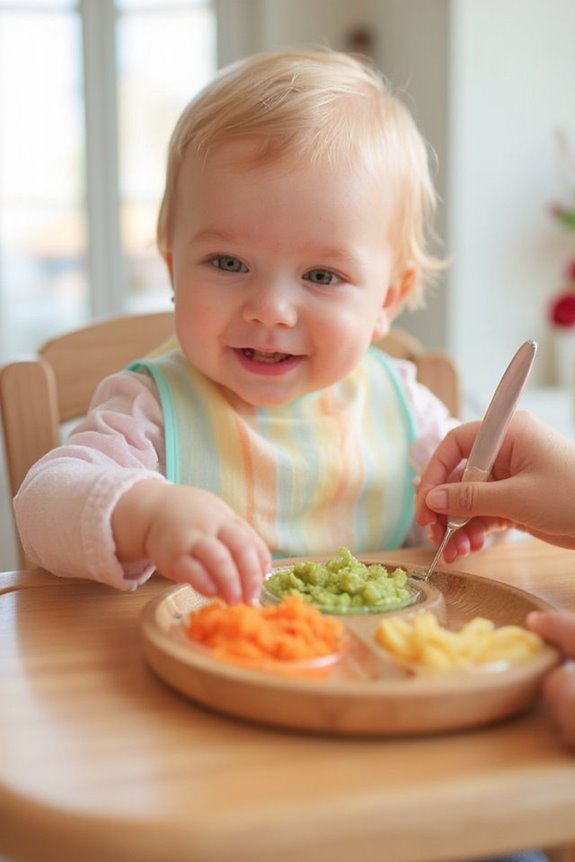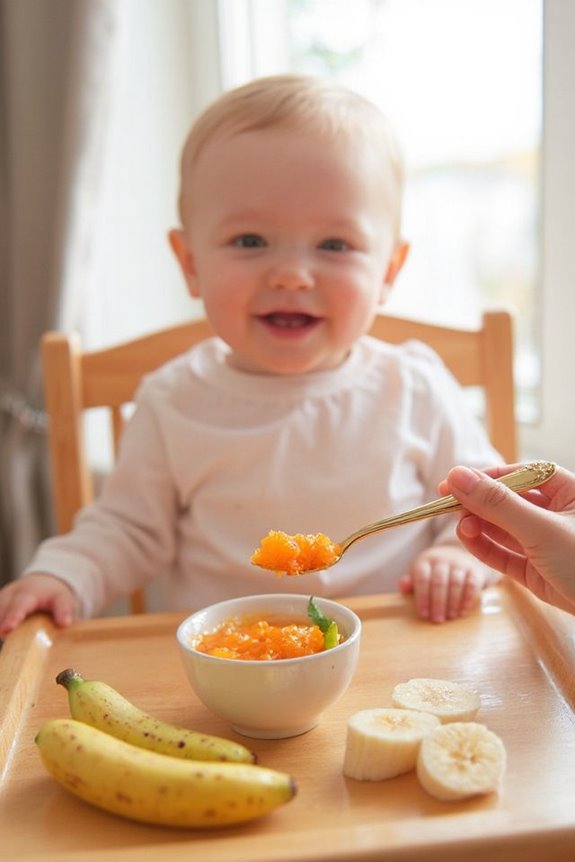Most babies are ready for solid foods around 6 months of age, though some may show readiness signs between 4-6 months. Look for these key indicators: good head control, sitting with support, showing interest in food, and reduced tongue-thrust reflex. I recommend starting with iron-rich foods like infant cereals or pureed meats, followed by single-ingredient fruits and vegetables. Always consult your pediatrician before beginning, as each baby’s development timeline varies. The following guidelines will help you navigate this exciting milestone safely.
Key Takeaways
- Most experts recommend introducing solid foods between 4-6 months, with 6 months being the ideal age.
- Babies should have good head control, sit with support, and show interest in food before starting solids.
- Early signs of readiness include opening mouth when food is offered and decreased tongue-thrusting reflex.
- Start with iron-rich, single-ingredient foods like infant cereals, pureed meats, or well-cooked vegetables.
- Breast milk or formula should remain the primary nutrition source throughout the baby’s first year.
Key Signs Your Baby Is Ready for Solid Foods
While most babies start showing readiness for solid foods around 6 months of age, it’s important that I watch for specific developmental signs rather than focusing solely on age.
Physical Development
- Good head control
- Ability to sit with minimal support
- Stable upper body posture
Baby Readiness Cues
- Shows interest by watching others eat
- Reaches for food on plates
- Opens mouth when offered food on a spoon
- Leans forward toward food
The most reliable feeding cues include decreased tongue-thrusting (no longer pushing food out) and improved coordination to move food to the back of the mouth for swallowing. I should also notice enhanced hand-eye coordination as my baby begins picking up objects and bringing them to their mouth.
Recommended Age and Developmental Milestones
Now that I’ve identified the signs of readiness in my baby, let’s look at what experts actually recommend about timing.
Optimal Age Range:
- Most experts suggest introducing solid foods between 4-6 months
- The WHO and AAP specifically recommend around 6 months
- Starting before 4 months is generally not advised
Key Developmental Indicators:
- Head and neck control (baby can hold head steady)
- Sitting with minimal support
- Showing interest in food during family meals
- Developed swallowing reflex
- Ability to reach for and grasp objects
These solid food readiness milestones are critical safety markers. While your baby might show these developmental indicators at different times, consulting with your healthcare provider remains essential before beginning solids, as they can assess your baby’s individual readiness.
Best First Foods to Offer Your Little One

Once you’ve determined your baby is ready for solids, choosing the right first foods becomes your next important decision. I recommend starting with single-ingredient options that are:
- Easy to digest
- Nutritionally dense
- Low allergy risk
Fruits like mashed bananas and avocados are excellent choices, as are well-cooked vegetables such as sweet potatoes and carrots. For protein, consider pureed chicken or mashed lentils.
Iron-rich foods deserve special attention since babies’ iron stores begin depleting around 6 months. Offer:
- Infant oat or barley cereal (not rice)
- Well-cooked pureed meats
- Mashed beans
Remember that baby preferences vary widely. If your little one rejects a food, try again in a few days—it often takes multiple exposures before acceptance.
Step-by-Step Guide to Starting Solids Safely

Beginning your baby’s solid food journey requires careful planning and attention to safety details. I recommend following these practical steps to guarantee a safe shift:
- Consult your pediatrician before starting solids (typically around 6 months)
- Confirm proper seating with head/neck support
- Start with single-ingredient purées
- Introduce new foods one at a time (3-5 days apart)
- Watch for allergic reactions, especially with common allergens
When developing your meal planning strategy, begin with one feeding daily and gradually increase. Always supervise feeding times to prevent choking hazards.
Effective feeding techniques include:
- Offering small amounts on a soft-tipped spoon
- Watching for fullness cues (turning away, closing mouth)
- Being patient with rejection—it may take 10-15 tries before acceptance
- Maintaining breast milk or formula as the primary nutrition source
Expert Nutritional Advice and Global Recommendations

With your baby’s safety foundation set, it’s important to understand what nutrition experts recommend about starting solids.
The expert consensus on solid food guidelines is remarkably consistent across major health organizations:
- Most experts recommend introducing solids between 4-6 months, with 6 months being ideal
- The WHO and AAP both advocate waiting until around 6 months
- Iron- and zinc-rich foods should be prioritized early, especially for breastfed babies
- Potentially allergenic foods can be introduced alongside other complementary foods between 4-6 months
- Human milk or formula remains the primary nutrition source throughout the first year
While some countries’ guidelines permit starting as early as 4 months if developmental readiness is shown, introducing solids before this age isn’t recommended due to increased health risks.
Frequently Asked Questions
Can Babies Eat Leftovers or Food Stored From Previous Meals?
I’d recommend caution with leftovers for babies. While properly stored food can be safe, I always guarantee leftover safety by reheating thoroughly and following proper food storage guidelines to prevent bacterial growth.
How Much Solid Food Should My Baby Eat at Each Meal?
I recommend starting with 1-2 teaspoons of puree, gradually increasing to 1-4 tablespoons. Portion sizes grow with your baby’s age, while meal frequency increases from once daily to 2-3 times as they develop.
Should I Offer Solids Before or After Breast Milk/Formula?
I’d recommend offering breast milk or formula first, then solids. This feeding schedule guarantees your baby gets essential nutrients while gradually increasing solid intake. For ideal nutrient absorption, follow your baby’s hunger cues throughout the shift.
Can I Add Herbs and Spices to My Baby’s Food?
Like a painter adding delicate touches, I’d wait until 8-10 months before introducing herb benefits to your baby’s palate. Start with mild flavors, monitor reactions, and prioritize spice safety by consulting your pediatrician first.
What if My Baby Refuses to Eat Solid Foods?
If your baby refuses solids, I’d respect their preferences while trying different feeding techniques like tiny portions or sensory play. Don’t force feed—offer variety, be patient, and consult a pediatrician if refusal persists.





